
RICHLAND, Wash. — EM’s Richland Operations Office awarded mission support contractor Hanford Mission Integration Solutions (HMIS) approximately $15.1 million in fee for work performed in fiscal year 2023, which ended September 30, 2023. HMIS earned 35% of the subjective fee and 98% of the objective fee, for an overall award fee of about 72%.
According to the award fee determination scorecard, HMIS exceeded several award-fee criteria and met overall cost, schedule, and technical performance requirements of the contract.
Noteworthy accomplishments include the following:
- Strong performance in site integration through the Hanford Site governance process.
- The services and infrastructure activities and operations delivered by HMIS supported operational testing of the facilities and systems for the Direct-Feed Low-Activity Waste Program as well as supporting key risk-reduction cleanup projects across the site.
- HMIS scored well for integrating and coordinating support activities for the cleanup mission (water, power, sewer, roads, fire, security, snow removal, and training) and met or exceeded 35 of 37 performance target levels.
Also noted in the scorecard, HMIS failed to effectively manage fire system maintenance personnel, work activities, and the associated costs. During the performance period, DOE was provided with evidence of numerous occasions when crews assigned to perform fire system maintenance were excessively idle and participated in nonwork-related activities due to ineffective work planning and unproductive work execution that went uncorrected by contractor management.
Other opportunities for improvement included:
- Improving communication/coordination when services (e.g., water, fire systems) are taken out of service so facilities can mitigate for impacts to operations.
- Improving fire apparatus pump, aerial and ground ladder testing to ensure equipment availability.
EM releases information relating to contractor fee payments — earned by completing the work called for in their contracts — to further transparency in its cleanup program.
View the HMIS fee determination scorecard here.
  EM Principal Deputy Assistant Secretary Jeff Avery, left, tours the Advanced Manufacturing Collaborative facility with DOE Savannah River Laboratory Office Director Tony Polk, center, during Avery’s recent visit to Aiken, South Carolina. The 60,000-square-foot facility is being built in partnership with Savannah River National Laboratory and the University of South Carolina-Aiken. It will provide a new laboratory, office and conference space suitable for advanced manufacturing research and development.
AIKEN, S.C. – EM Principal Deputy Assistant Secretary Jeff Avery joined an official with the National Nuclear Security Administration (NNSA) to visit with community members and other stakeholders of the Savannah River Site (SRS) last week.
As part of their visit, Avery and NNSA Principal Deputy Administrator Frank Rose met with the SRS Citizens Advisory Board to welcome the board’s incoming chair, Phyllis Britt, and vice-chair, Kandace Cave. They also thanked outgoing chair Gregg Murray and outgoing vice-chair Charles Hilton for their service, and discussed the upcoming transition of authority for SRS from EM to NNSA.
The board is a stakeholder group that provides DOE advice, information and recommendations on issues affecting the EM program at SRS.
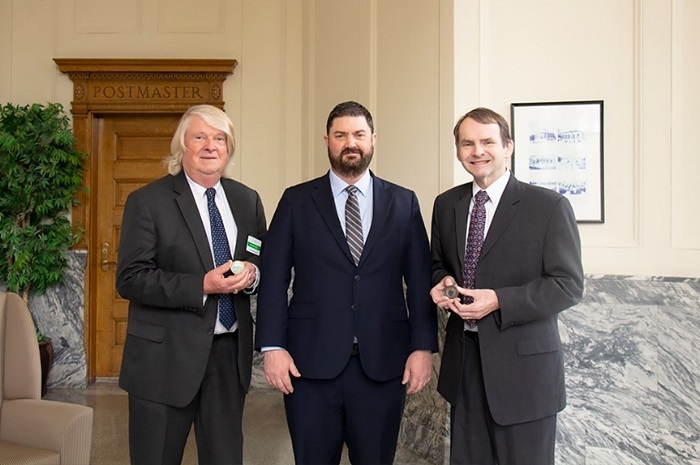 EM Principal Deputy Assistant Secretary Jeff Avery, center, presents honorary coins to outgoing Savannah River Site Citizens Advisory Board Chair Gregg Murray, right, and Vice-Chair Charles Hilton for their service during Avery’s visit to Aiken, South Carolina, and Savannah River Site.
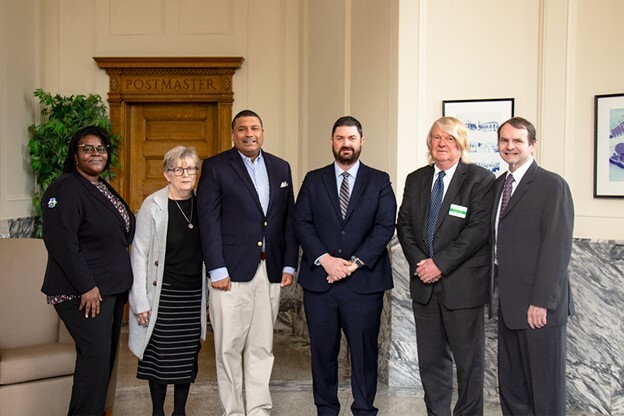 EM Principal Deputy Assistant Secretary Jeff Avery, center right, welcomes incoming Savannah River Site Citizens Advisory Board Vice-Chair Kandace Cave, far left, and Chair Phyllis Britt, second from left. Avery also thanked outgoing vice-chair Charles Hilton, second from right, and chair Gregg Murray, far right, for their service. Also pictured at center left is National Nuclear Security Administration Principal Deputy Administrator Frank Rose.
As part of the tour, Avery viewed progress at the Advanced Manufacturing Collaborative, a facility being built in partnership with the Savannah River National Laboratory (SRNL) and the University of South Carolina-Aiken. The facility will provide a new laboratory, office and conference space suitable for advanced manufacturing research and development. Crews placed the last piece of structural steel on the 60,000-square-foot facility in November, delivering an EM 2023 priority ahead of schedule.
Avery attended a Savannah River Site Community Reuse Organization networking reception, titled, “An Evening with Department of Energy Leadership,” with guest speakers Jill Hruby, under secretary for nuclear security and administrator of NNSA, and Rose.
 EM Principal Deputy Assistant Secretary Jeff Avery provides remarks at a Savannah River Site Community Resue Organization reception.
In his remarks, Avery highlighted the recent 30th anniversary milestone for the community reuse organization. The nonprofit group’s mission is to facilitate economic development opportunities associated with SRS technology, capabilities and missions, and to serve as an informed, unified community voice for the two-state region, which includes the counties of Aiken, Allendale, and Barnwell in South Carolina and Columbia and Richmond in Georgia.
Avery also focused on SRS cleanup accomplishments of the past year. Those EM achievements include record production at the site’s Salt Waste Processing Facility, treating nearly 3.2 million gallons of salt waste in 2023 and more than 7 million gallons of salt waste in just over three years of operation. Avery also noted the completion of construction of Saltstone Disposal Unit 8; the first shipment of downblended plutonium for offsite disposal; and the start of acceptance of highly enriched uranium-235 from L Basin as part of the Accelerated Basin De-Inventory campaign.
-Contributor: Eleanor Prater
  Isotek employees load a canister of high dose U-233 material for processing in hot cells.
OAK RIDGE, Tenn. — The Oak Ridge Office of Environmental Management (OREM) and contractor Isotek are moving forward on the highest priority cleanup project at Oak Ridge National Laboratory (ORNL): eliminating the remaining inventory of uranium-233 stored onsite.
Isotek recently began the second phase of its current processing campaign. This portion of the uranium-233 inventory measures 15-20 times higher in radiological dose than the previous material employees have processed to date.
Isotek has processed approximately 15% of the inventory within the current campaign. The efforts underway kick off the second phase, and a third phase remains to complete the current campaign, which is slated for completion in 2026.
Previous processing activities focused on an inventory of oxides manufactured in Oak Ridge, but the material currently undergoing processing involves oxides originating from the Savannah River Site decades ago. That material contains higher concentrations of the uraniun-232, which results in higher doses.
“After processing the lower dose uranium-233 oxide material during the first year of hot cell operations, we were able to gain proficiency and implement many lessons learned for this higher dose material,” said Isotek Project Manager Sarah Schaefer.
 Processing is now underway on the second phase of Isotek’s current processing campaign. This portion of the inventory measures 15-20 times higher in radiological dose than the previous material employees have processed to date.
The nation’s inventory of uranium-233 has been stored at ORNL for decades. It was originally created in the 1950s and 1960s for potential use in reactors, but it proved to be an unviable fuel source.
OREM and Isotek are tasked with eliminating the material because it presents risks and is costly to keep safe and secure. The Uranium-233 Disposition Project is removing this inventory of Cold War-era nuclear material stored in the world’s oldest operating nuclear facility.
Half of the original uranium-233 inventory stored at ORNL was directly disposed of in 2017, while the remaining material required processing and downblending to convert it into a form that can be safely transported and disposed of. Isotek started processing lower dose material in gloveboxes in 2019, and then began processing higher dose material in hot cells in 2022.
As part of the processing operations, employees remove transuranic material and lessen enrichment levels to avoid the potential for criticality, or an accident resulting from an inadvertent, self-sustaining nuclear chain reaction. They are also extracting thorium-229, a rare medical isotope, to advance next generation cancer treatment research.
-Contributor: John Gray
 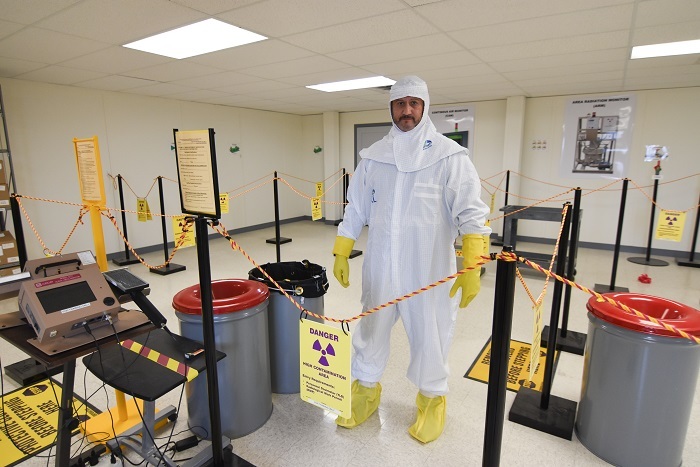 Waste Treatment Completion Company Radiological Control Training Instructor Chris Oliveros poses inside a new radiological control training classroom at the Hanford Site’s Waste Treatment and Immobilization Plant.
RICHLAND, Wash. — The training team at the Hanford Site’s Waste Treatment and Immobilization Plant (WTP) recently added an extra level of realism to employee trainings by upgrading classrooms and adding new props.
The improvements are intended to build operational readiness by allowing students to train in scenarios that closely resemble what they will encounter on the job.
Mat Irwin, EM Office of River Protection acting assistant manager for the Waste Treatment and Immobilization Plant Project, believes the changes will be beneficial.
“These improvements bridge the gap between training and practical application. When the students encounter situations like what they’ve practiced, they’ll be better equipped to handle them,” he said.
The WTP radiological worker training program now features a classroom set up to simulate working in a radiological environment. Students are required to wear protective gear, just as they would in the field. The classroom also includes a dedicated space for students to practice putting on and removing personal protective equipment.
“We've intensified the challenges, mirroring the intricacies of accessing radiologically controlled areas,” said Owen Peters, training and procedures manager for Waste Treatment Completion Company, a subcontractor to WTP lead contractor Bechtel National, Inc. “We've even introduced fluorescent materials to demonstrate how contamination spreads in the absence of proper radiological practices."
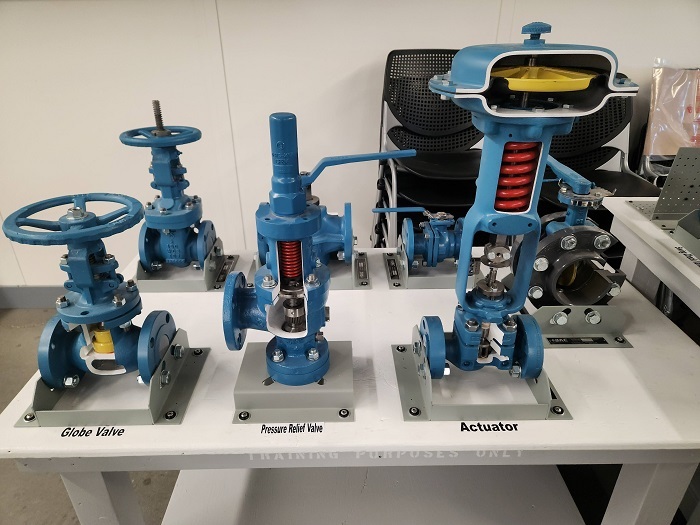 By cutting away parts of valves, the Waste Treatment and Immobilization Plant’s new training props show students the inner workings of valve systems.
Elsewhere on the WTP jobsite, a new set of training props are helping students gain a better understanding of valve systems. Fourteen different types of valves have had pieces cut away to reveal their inner mechanisms.
“These cutaway props allow students to enhance their understanding of valve systems and apply that to their work," said Sara Hannickel, operations training supervisor for Waste Treatment Completion Company. “The hands-on training is contributing to fewer errors in the field and providing an all-around better learning experience."
-Contributor: Tyler Oates
 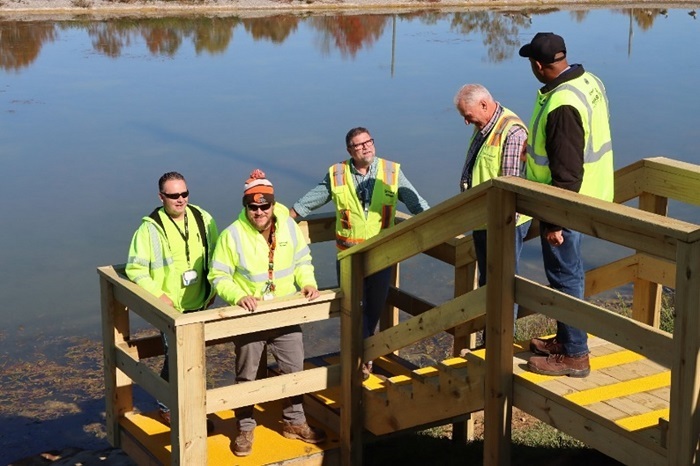 From left, environmental science technicians David Chandler and Andrew Hobstetter, Environmental Media Supervisor Stacy Claggett, Construction Manager Brian Klaiber and Environmental Science Manager Marc Hill take a close look at new steps near a sedimentation and detention pond.
PIKE COUNTY, Ohio — Environmental science technicians have upgraded their equipment and taken other steps to make jobs safer at EM’s Portsmouth Site, helping eliminate slip, trip and fall hazards at multiple difficult-to-reach locations.
Changes suggested by the technicians to remove hazards included installing stairs to ease the navigation of steep hillsides and using backpacks to carry samples and supplies. Within a short time, workers constructed steps in two locations, and the site selected ergonomic backpacks for use by the technicians.
“Our personnel are alert to changing conditions and anticipate potential changes,” Portsmouth Site Lead Jeremy Davis said. “This proactive approach benefits our workforce today and in the future.”
The technicians collect samples from the Portsmouth outfalls on a daily to annual basis, depending on the location, the samples being analyzed and permit requirements. In addition to regular samples, quality control samples are gathered, adding to the volume collected. Sample results are reported to the Ohio Environmental Protection Agency in monthly operating reports. Last year, approximately 358 samples were collected from the outfalls.
Access to some of the sampling locations can be problematic under certain weather conditions. In addition to installing steps with handrails, a non-slip tread was added to the steps and landing areas.
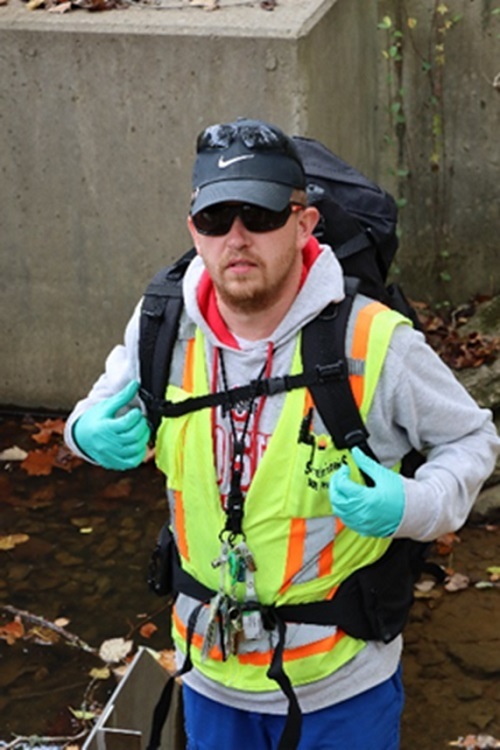 |
|
Portsmouth Site Environmental Science Technician Richie Wagner uses a new backpack to carry sampling equipment to surface-water sampling locations. |
Another safety measure recently implemented supports safer sampling at all locations. The technicians now wear new ergonomic backpacks with adjustable straps and lower back and hip support. This is considered a safer option for technicians instead of the coolers previously used for sampling equipment. Additionally, this will permit technicians to hold onto handrails for better balance on rough terrain.
“The technicians were enthusiastic when we presented the idea of the backpacks,” Environmental Media Supervisor Stacy Claggett said. “The fit is adjustable and can be utilized at 600 sampling locations both on- and off-site.”
Claggett added, “Options like these produce easier, safer and more efficient jobs for workers who bear the elements year-round to help meet site regulatory commitments."
-Contributor: Michelle Teeters
 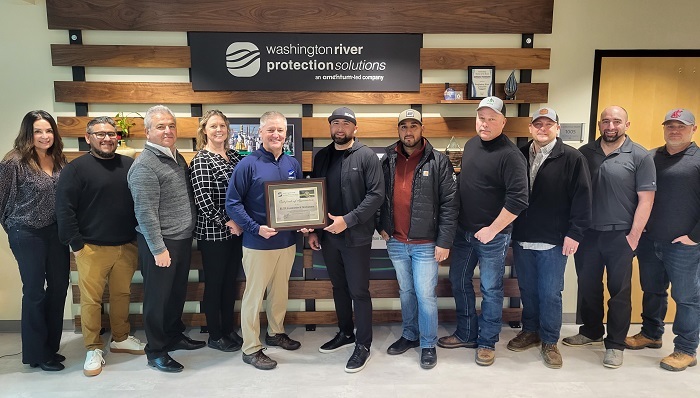 Pictured from left, Grace Lieberman, Elite Construction & Development director of business development; Victor Espinoza, Washington River Protection Solutions (WRPS) procurement specialist; Jose Legarreta, WRPS procurement manager; Staci Downing, WRPS Small Business Program manager; Wes Bryan, WRPS president and project manager; Trini Garibay, Elite CEO; David Magaña, Elite chief operating officer; Levi Sherman, Elite construction manager; Scott Kukes, Elite project manager; CJ Black, Elite project executive; and Kyler Davenport, Elite environmental safety and health specialist were among those who attended an event to present a DOE Mentor-Protégé Program completion certificate to Elite at a WRPS facility.
RICHLAND, Wash. — EM Office of River Protection (ORP) tank operations contractor Washington River Protection Solutions (WRPS) recently awarded a certificate for completing the DOE Mentor-Protégé Program to a local company.
The program is an avenue for DOE contractors to assist small businesses by enhancing their capabilities to perform contracts and subcontracts for federal agencies. The company, Elite Construction & Development of Pasco, Washington, partnered with WRPS to support the Hanford Site cleanup mission.
“Part of our commitment is to help small and disadvantaged businesses to be successful,” said Nicole Schuller, WRPS acting assistant manager for procurement. “Mentoring small, local businesses helps ensure they’re fully equipped to compete for federal contracts, which invests in the local economy and enables more families to continue the Hanford cleanup legacy.”
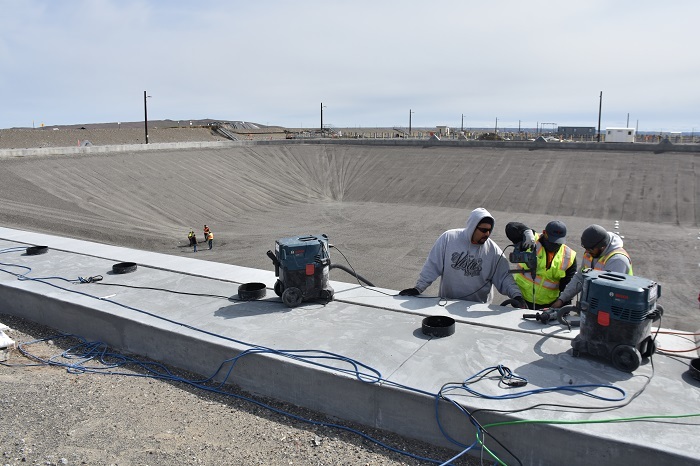 Elite Construction & Development assisted in constructing a liquid retention basin, one of many significant upgrades required to support the Direct-Feed Low-Activity Waste Program to treat tank waste at the Hanford Site.
WRPS mentored Elite in developing government-furnished property procedures, invoicing and closeout procedures, implementing a new accounting system and developing a quality assurance program. Elite also accompanied WRPS to outreach events.
The relationship between WRPS and Elite began in fiscal year 2019 with a mentor-protégé agreement and expanded to include work on multiple projects.
Fiscal year 2023 marked the end of Elite’s fifth and final year in the program.
“We appreciate WRPS for inviting us to take part in the DOE mentor-protégé partnership and providing us the opportunity to prove ourselves in the EM sector,” said Trini Garibay, Elite president and CEO. “The knowledge gained in the past five years has transformed our organization into the best version of itself. We look forward to sustaining our role as a trusted partner.”
Beyond the Mentor-Protégé Program, WRPS awarded more than $4.6 million to small businesses in fiscal year 2023, including small, disadvantaged businesses, women-owned small businesses, veteran-owned small businesses, and historically underutilized businesses.
-Contributor: Derek Miceli
 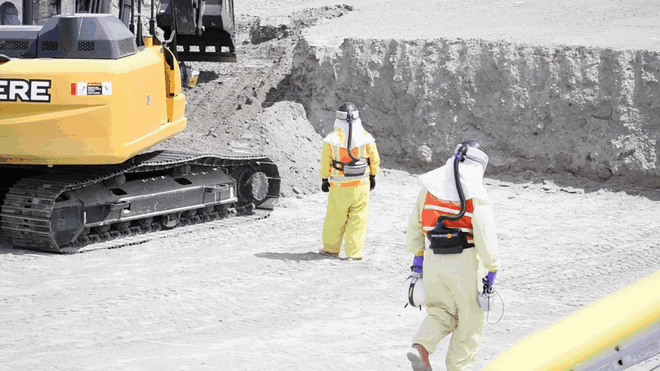 In early 2023, Newport News Nuclear BWXT Los Alamos (N3B) awarded a five-year subcontract valued at more than $32 million to City State of Knoxville, Tennessee, to provide radiological control technicians to support legacy waste cleanup on behalf of the EM Los Alamos Field Office. City State is a HUBZone small business, and the subcontract was one of many procurements that led to N3B far exceeding its small business subcontracting goals in 2023. HUBZones are historically underutilized business zones.
LOS ALAMOS, N.M. — Newport News Nuclear BWXT Los Alamos (N3B), the EM Los Alamos Field Office (EM-LA) legacy waste cleanup contractor at the Los Alamos National Laboratory, awarded more than 80% of its nearly $290 million in planned purchases in the fiscal year that ended Sept. 30 to small businesses, beating its goal of 65%.
“We had significantly more purchasing activity in 2023 with an increase of $134 million in total purchases over the previous year,” said Julie Baer, N3B small business manager. “Ensuring we were able to meet our small business goals with such a large increase in overall purchasing took significant planning and forethought.”
This was the second year in which N3B exceeded all of its subcontracting goals in small business categories. The company awarded 35%, or $102 million, to small, disadvantaged businesses, and 18%, or $51 million, to woman-owned small businesses.
Baer attributed the increased purchasing activity to two staff augmentation subcontracts being awarded to small businesses, one of which was an economically disadvantaged woman-owned small business. Additional purchases included a small business subcontract for access control specialists and one for radiological control technicians with a HUBZone small business. HUBZones are historically underutilized business zones.
“N3B was able to keep pace with the increased procurement activity by being more disciplined in seeking out potential vendors that met the small business requirements to let them know about upcoming procurement opportunities,” Baer said.
-Contributor: Todd Nelson
|






